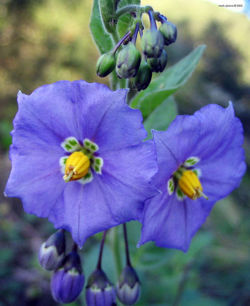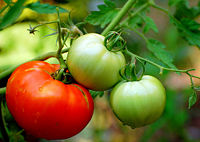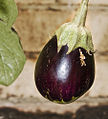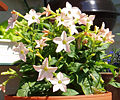Solanaceae
| Solanaceae |
|---|

|
| Scientific Classification |
|
| Selected Genera |
|
Solanaceae is a taxonomic Family of plants that comprises 95 genera of some of the most adaptable flowering plants known to man. Also known as the Potato Family, it includes several common vegetables (potatoes, peppers, tomatoes), ornamentals (petunias, snapdragons), leafy greens (the traditional "nightshades"), and alkaloid producers (including coffee, tobacco, belladonna, and mandrake).[1][2][3]
Anatomy
Solanaceae is a family of flowering plants with diverse anatomies. They are multicellular eukaryotes and their cells have cell walls made from cellulose. Their cells also contain chlorophyll a and b, like all plants, which allows them to absorb sunlight and carry out photosynthesis. Many of these plants are fruit bearing which explains how they are spread so far and wide. The family Solanacaeae includes herbs, trees, and shrubs. They are dicotyledons so they emerge from the ground with two seed leaves.
Like all plants, the Solanaceae family have the basic, most important parts of a plant: leaves, stem, and roots. The veins of their leaves branch out which is common for dicotyledons.(Miller and Levine p586) The leaves can be either petioled or sessile depending on the species. They also are the main photosynthetic system, with a large surface area to increase the amount of sunlight absorbed. They also contain subsystems within the leaves to prevent large amounts of water loss due to being exposed to the dryness of the air. The roots of the plants in the Potato family form what is called a taproot. The roots are an extremely important part of the plant because it absorbs water and dissolved nutrients while simultaneously protecting them from bacteria and fungi that would harm the plant. They can be located in the air or completely underground, like the potato.
While the stem provides support for the plant, it also acts as a transportation system, delivering water and nutrients to the many parts of the plant. The stem of the plants in the Potato family can be either woody or herbaceous depending on their species. Within the stems, there are vascular bundles that contain xylem and phloem and since they are dicots, these vascular bundles are arranged in a ring-like pattern as opposed to the unorganized monocot stem. These basic parts of Solanaceae plants are comprised of many different kinds of tissues. The outer covering of a plant is made of dermal tissue. Most commonly this layer of tissue is covered in a waxy coating called the cuticle made of epidermal cells which help prevent water loss.
Another tissue within these plants is vascular tissue which contains specialized cells called Xylem or Phloem, both of which help transport water and nutrients throughout the plant.(Miller and Levine p581) The last type of tissue that makes up these plants is ground tissue. Ground tissue is made up of all the cells that are in between the dermal tissue and vascular tissue.(Miller and Levine p582)
Reproduction
The Potato family is fruit bearing and so protects its seeds by encasing them in fruit. Most of these fruits are edible but many are poisonous. The flower is the reproductive structure of these plants and contains the ovule, ovary, sepal, stamen, carpel, and petals.(Miller and Levine) They are most commonly conical or funnel-shaped with five fused petals.
Sepals appear to be ordinary leaves but they are not, they enclose the bud prior to it opening and protect it from harm while it develops. The petals are important because insects are attracted to them and flowers rely on the insects for pollination. The male parts make up the stamen. The stamen contains the filament and an anther.(Miller and Levine) The filament is a stalk that supports the anther, which is where meiosis takes place and produces male gametophytes. While the carpels create the female gametophyte. When these flowers become pollinated, the ovary of the flower develops into a fruit which protects it even more and poses as a tasty treat to animals so that they would take the seed far away. The fruits develop from a maturing ovary and than the embryo later. The seed has an outer layer that protects the embryo that froms from the ovule.(Miller and Levine) All of the components that make up the reproductive system of these amazing plants play a major role in their survival.
Ecology
Members of the Potato family are found in a very large variety of climates, from tropical rainforests to deserts to snow-covered mountains.[1] We can attribute this to the adaptability of these amazing plants. They have spread with the help of their fruits which many ecosystems rely on. Humans rely on the Potato family for all kinds things, they play a major part of the economy in many parts of the world.
Human use of Solanaceae
The Nightshade family has been used heavily by humans. The practical implications of utilizing the chemicals or fruits of these plants are huge. Many of our most widely used foods were made from fruits that came from plants in the Solanaceae family. Tomatoes are enjoyed by many people in such foods as pizza, spaghetti, and others. Also, the potato is a member of this family. The potato has been a large part of many cultures diets throughout history.[1] They are also used for medicinal purposes. This is because they have very powerful alkaloids within their cells.[2] Tobacco, which is the most widely used drug besides alcohol, is also a member of this family. In shamanistic religions, shamans used plants from the family Solanaceae to induce hallucinations.
Gallery
Irish Potato
(S. tuberosum)
Genus: SolanumEggplant
(S. melongena)
Genus: SolanumJasmine Tobacco
(N. alata)
Genus: NicotianaMandrake
(M. autumnalis)
Genus: MandragoraGarden Tomato
(S. lycopersicum)
Genus: SolanumBelladonna
(A. bella-donna )
Genus: Atropa
References
- ↑ 1.0 1.1 Authors unknown. "About the Solanaceae family." Sol Genomics Network. Accessed January 2, 2008.
- ↑ "The Solanaceae Family." The Vaults of Erowid. Accessed January 2, 2008.
- ↑ "Solanaceae." Encyclopedia Britannica Online. Accessed January 2, 2008.
- Prentice Hall Biology by Kenneth R. Miller and Joseph S. Levine by Pearson Education, Inc., publishing as Pearson Prentice Hall, Boston Massachusetts
- About the Solanaceae Family Sol Genomics Network, Unknown Authors.
- Solanaceae Encyclopedia Britannica
- The Solanaceae as Drugs and Medicine: A Natural History of the Potato Family Fathom Knowledge Network, From The Natural History Museum, By Sandra Knapp.







